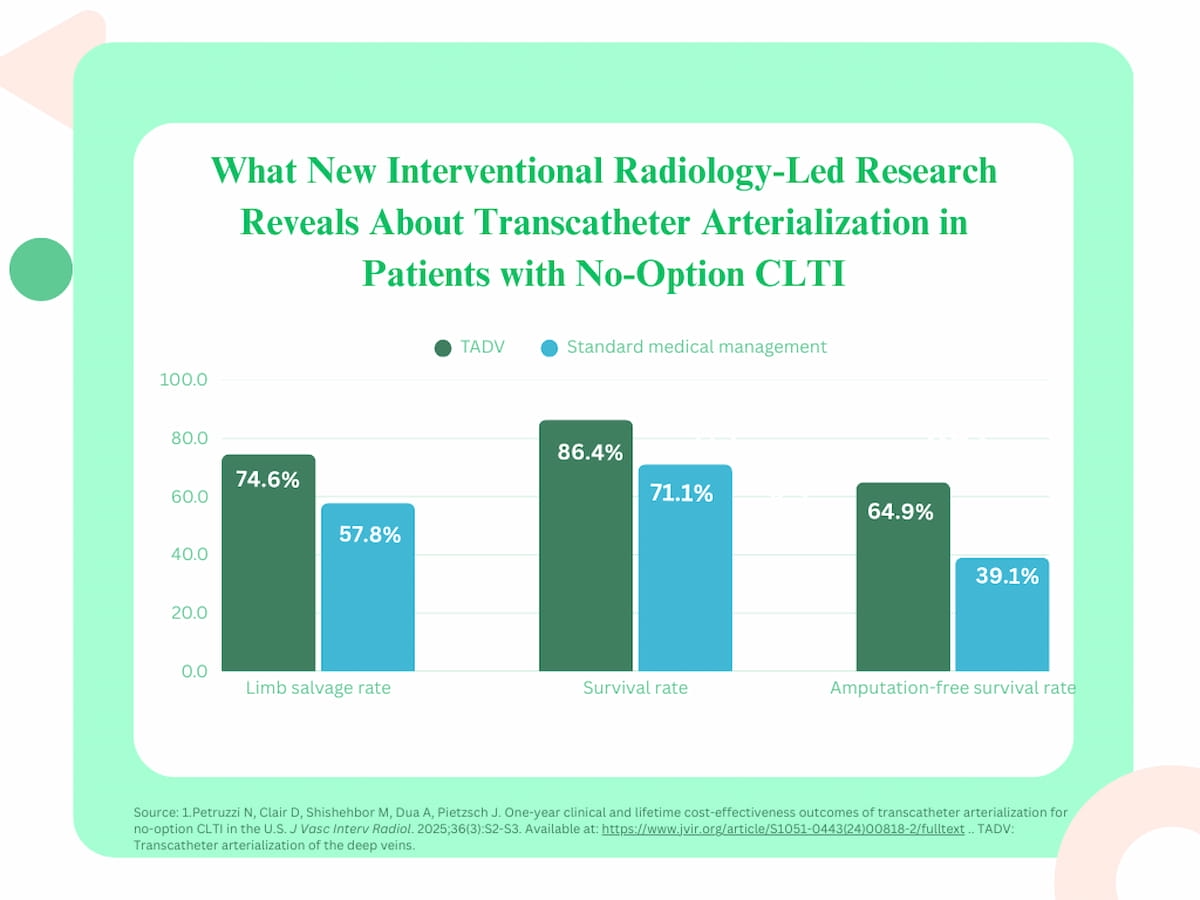Interventional Radiology-Led Study Shows Significant Limb Salvage Benefits with Transcatheter Arterialization
For patients with no-option chronic limb-threatening ischemia (CLTI), transcatheter arterialization provided over a 25 percent higher amputation-free survival rate over standard medical management at one year, according to research presented at the Society of Interventional Radiology (SIR) Annual Scientific Meeting.
Transcatheter arterialization of the deep veins (TADV) facilitates significantly improved outcomes in patients with chronic limb-threatening ischemia (CLTI) who are not eligible for open or endovascular treatment, according to new research presented at the Society of Interventional Radiology (SIR) Annual Scientific Meeting.
For the study, researchers employed propensity-score matching to compare TADV (LimFlow System, Inari Medical) versus standard medical management in 228 patients with CLTI who were not eligible for open or endovascular treatment (also referred to as patients with “no-option” CLTI).
In new research presented at the Society of Interventional Radiology (SIR) Annual Scientific Meeting, transcatheter arterialization of the deep veins (TADV) provided significantly improved limb salvage, survival and amputation-free survival rates in comparison to standard medical management in patients with no-option chronic limb-threatening ischemia (CLTI).

The study authors found that patients in the TADV cohort had a 16.8 percent higher limb salvage rate (74.6 percent vs. 57.8 percent), a 15.3 percent higher survival rate (86.4 percent vs. 71.1 percent) and a 25.8 percent higher amputation-free survival rate (64.9 percent vs. 39.1 percent).
“TADV was associated with significantly improved limb salvage, survival, and amputation-free survival at 1 year compared to contemporary benchmark for no-option CLTI patients,” wrote lead study author and interventional radiologist Nicholas Petruzzi, M.D., FSVM, DABR, who is affiliated with Atlantic Medical Imaging in New Jersey, and colleagues.
(Editor’s note: For related content, see “Diagnosing Cardiac Ischemia in Women: Key Imaging Considerations,” “What New Computed Tomography Research Reveals About Predicting Diabetes and Cardiometabolic Risks” and “Predicting Diabetes on CT Scans: What New Research Reveals with Pancreatic Imaging Biomarkers.”)
Findings from the research, which garnered “Abstract of the Year” honors with three other abstracts presented at the SIR conference, also revealed that TADV was a cost-effective option that may increase life expectancy in patients with no-option CLTI by more than two years in comparison to standard medical management.
“Over a patient’s lifetime, TADV added 1.09 (quality-adjusted life years) QALYs (2.25 vs 1.16) with a resulting ICER (incremental cost-effectiveness ratio) of $33,011 per QALY gained. The total projected survival gain with TADV was 2.18 life years,” pointed out Petruzzi and colleagues.
Reference
1. Petruzzi N, Clair D, Shishehbor M, Dua A, Pietzsch J. One-year clinical and lifetime cost-effectiveness outcomes of transcatheter arterialization for no-option CLTI in the U.S. J Vasc Interv Radiol. 2025;36(3):S2-S3. Available at: https://www.jvir.org/article/S1051-0443(24)00818-2/fulltext .
What New Research Reveals About Novice Use of AI-Guided Cardiac Ultrasound
April 4th 2025In a study recently presented at the American College of Cardiology (ACC) conference, researchers found that novice use of AI-guided cardiac ultrasound after an AI-enabled electrocardiogram increased the positive predictive value for reduced left ventricular ejection fraction (LVEF) or aortic valve stenosis by 33 percent.
GE HealthCare Debuts AI-Powered Cardiac CT Device at ACC Conference
April 1st 2025Featuring enhanced low-dose image quality with motion-free images, the Revolution Vibe CT system reportedly facilitates improved diagnostic clarity for patients with conditions ranging from in-stent restenosis to atrial fibrillation.
New AI-Enabled Portable Ultrasound May Facilitate 50 Percent Reduction in Cardiac Imaging Scan Time
March 28th 2025Artificial intelligence (AI)-powered measurement capabilities provide key features with the Compact Ultrasound 5500CV device, which was unveiled at the American College of Cardiology (ACC) conference.
GE HealthCare Launches PET MPI Agent Flyrcado at ACC Conference
March 28th 2025The positron emission tomography myocardial perfusion imaging (PET MPI) agent, which offers a significantly higher half-life than other cardiac PET agents, was recently granted pass-through payment status by CMS that will go into effect on April 1, 2025.
New Collaboration Offers Promise of Automating Prior Authorizations in Radiology with AI
March 26th 2025In addition to a variety of tools to promote radiology workflow efficiencies, the integration of the Gravity AI tools into the PowerServer RIS platform may reduce time-consuming prior authorizations to minutes for completion.
New Analysis Forecasts Substantial Cost Savings with the Use of Photon Counting CT for CCTA
March 8th 2025The use of ultra-high-resolution photon-counting CT in the evaluation of stable chest pain may significantly reduce follow-up tests and invasive coronary angiography (ICA) procedures, possibly resulting in millions in health-care cost savings, according to a cost-effectiveness analysis presented recently at the European Congress of Radiology.